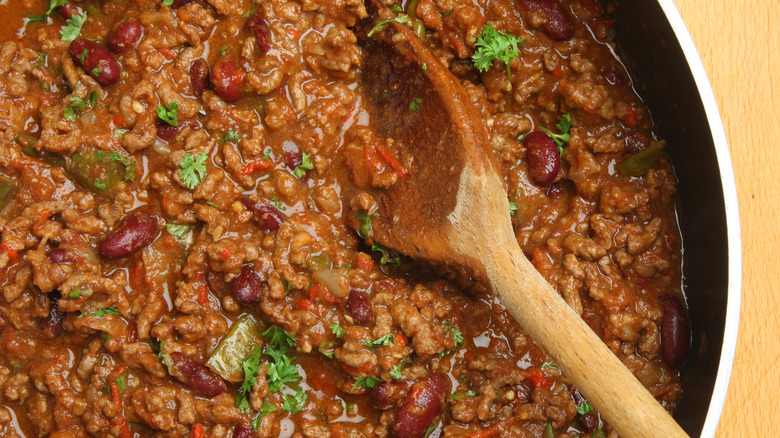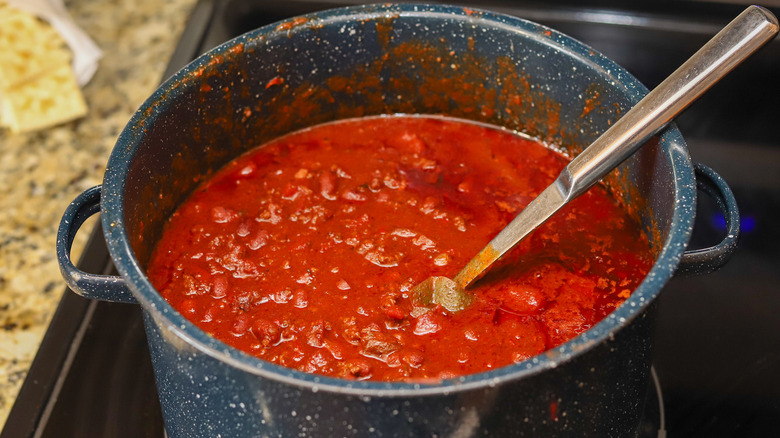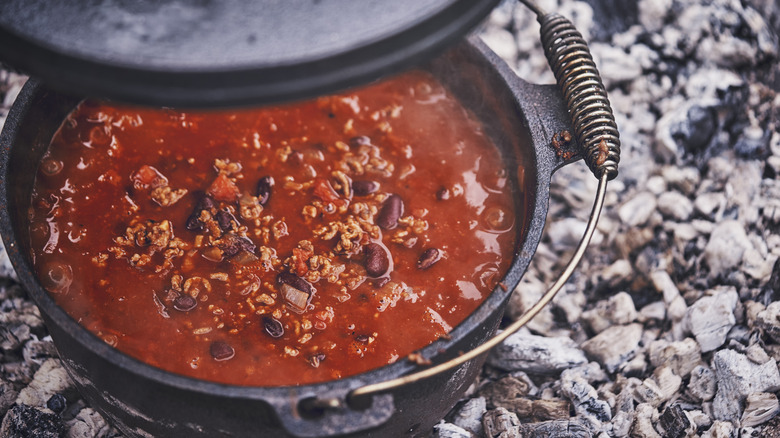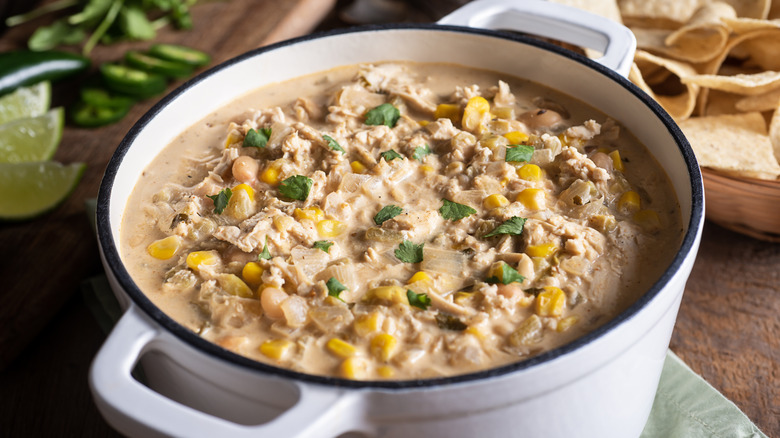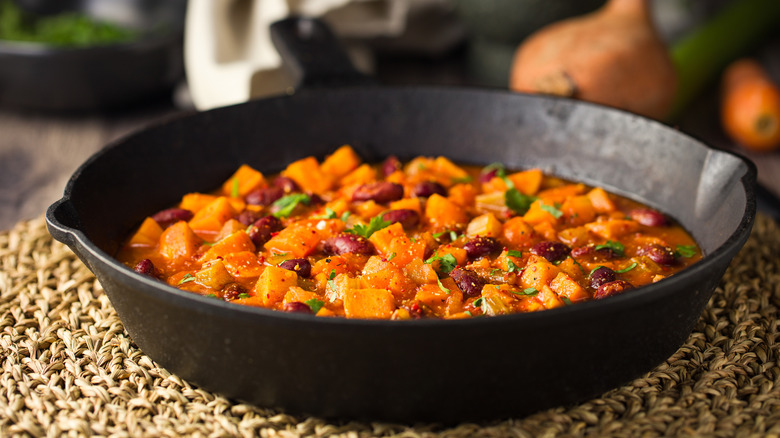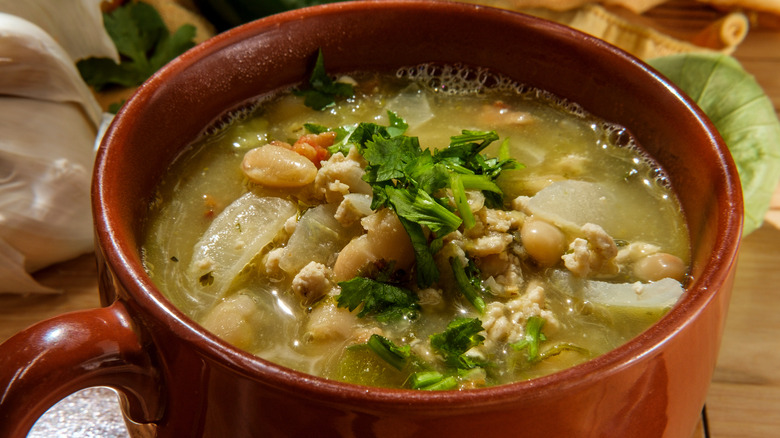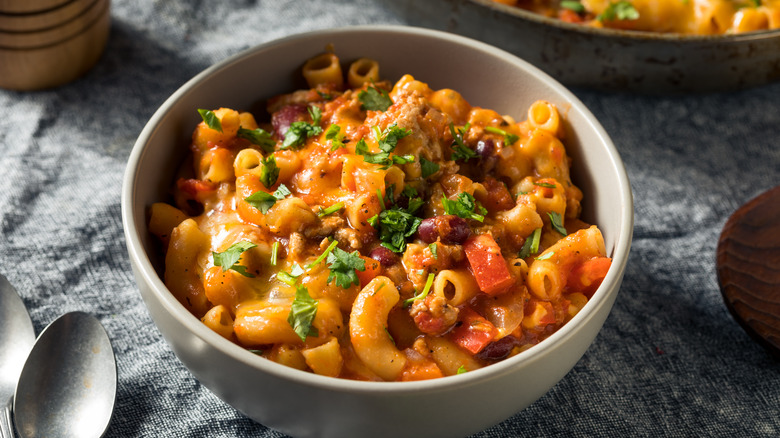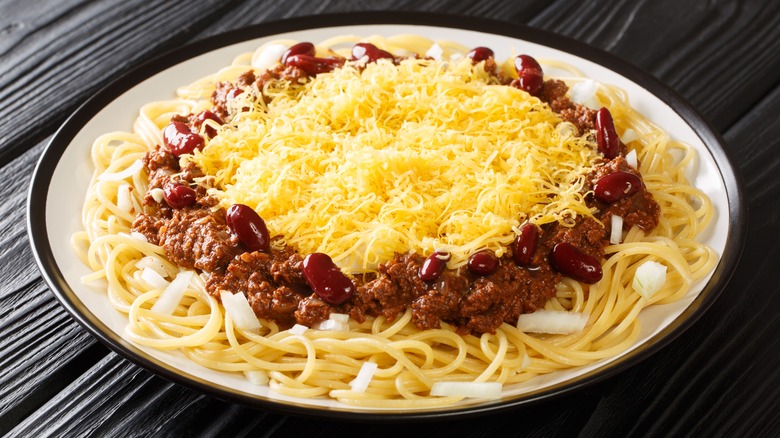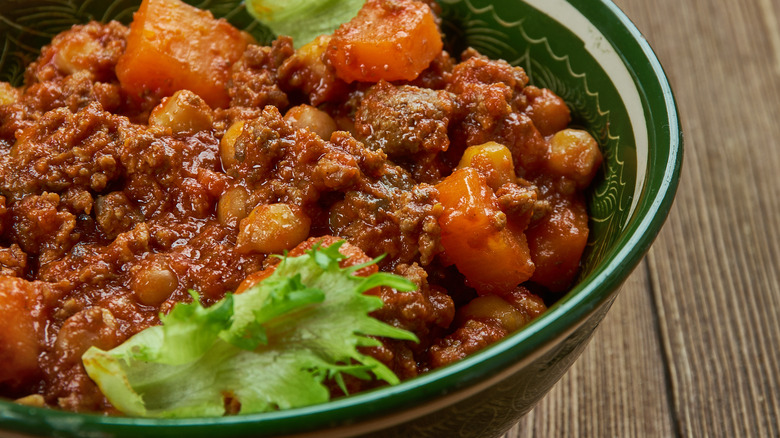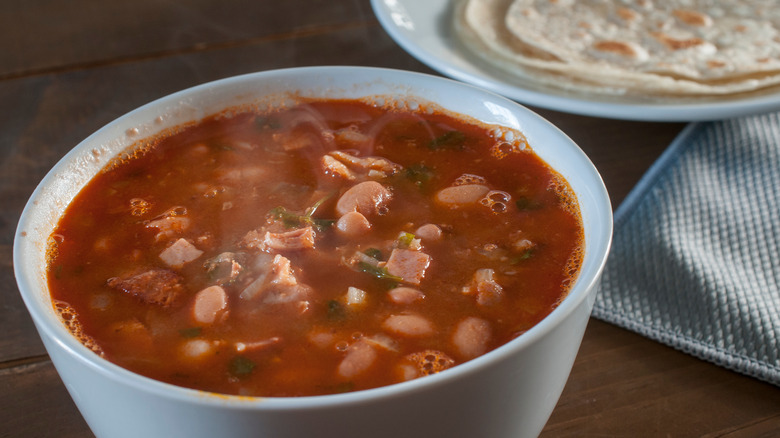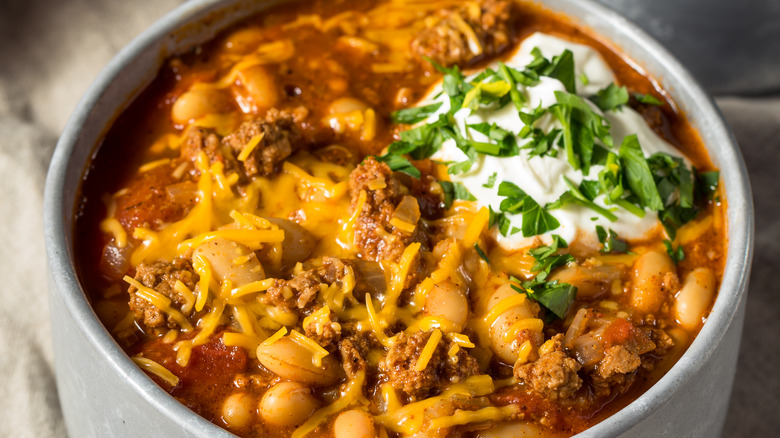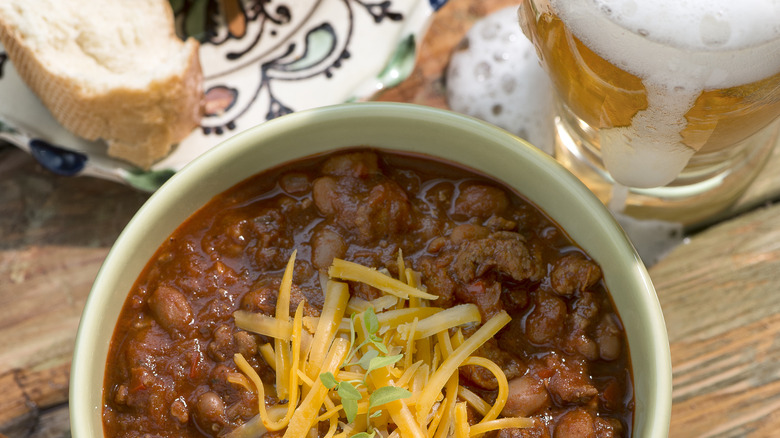10 Types Of Chili To Know, Make, And Share
There's nothing like a good bowl of chili! Whether you're looking for something hearty and savory on a cold day or you're tailgating with friends, chili is the perfect dish for all kinds of occasions. It's a classic comfort food that's relatively healthy and easy to make. It always brings a smile — and thoughts of home and growing up — wherever it's served.
Not a lot is known about the origins of this incredible dish. Food historians estimate that indigenous populations started using spicy chili peppers in their meals thousands of years back, dating to the times of Aztecs and Mayans and well before. When Spanish explorers arrived in the Americas in the 16th century, they loved the chili peppers the locals introduced them to so much, they brought them back to Europe, further spreading the principle ingredient that gives chili its heat around the globe.
Among all this travel and history, some ingenious individual decided to drop a few chili peppers into a pot with meat, beans, and tomatoes — and chili (as we know it today) was born. In 2020, an estimated 125 million Americans regularly enjoyed a bowl of chili. It truly is a perfect meal. And it's one that can be personalized in nearly infinite ways. Read on for 10 of our favorite chili twists and tweaks, all of which are easy to make, super tasty, and ideal for sharing.
The basics of chili
Making a standard pot of chili couldn't be easier. You just need a few basics — ground meat, onion, garlic, tomatoes, beans, and spices including some type of chili powder. A large pot with a lid is also helpful. To get started, put your pot on the stove over medium-heat. Next, add 1 pound of ground meat (beef, chicken, turkey, and pork are all good options) to the pot and brown until it's cooked through and no longer pink.
As the meat cooks, dice 1 large onion and mince 3 to 4 cloves of garlic and then add them to the pot, sautéing until translucent. The spices come next: Add 2 to 3 tablespoons of chili powder, 1 to 2 teaspoons of ground cumin, 1 to 2 teaspoons of paprika, and 1 teaspoon of dried oregano (plus salt and pepper to taste) to your meat and onion mixture.
Finally, dump a 14-ounce can of diced tomatoes or the equivalent amount of fresh, diced tomatoes into the pot, plus an (optional) drained, rinsed 15-ounce can of kidney beans, pinto beans, or black beans — and mix well. For a soupier chili, you can also add a cup of tomato sauce to your creation. Lower the stove's heat to low, cover your pot, and let everything simmer for at least 30 minutes — and voila, your homemade chili is ready to go. Just add some toppings and dig in!
Chili con carne (aka Texas chili)
While almost all standard types of chili contain some kind of meat, when you make chili con carne (which literally translates as "chili with meat"), you want your meat to be the star of the dish. One easy way to make sure your meat really shines in a bowl of chili con carne is to opt for the highest quality ground beef available. You might buy ground Angus beef, which is generally leaner and more tender than "regular" beef. Or, simply pick a pack of ground beef with a lower fat content: instead of 80/20, splurge on the 90/10 or 93/7 (which contains 93% lean meat and 7% fat). Ground beef mixtures containing less fat typically come from leaner cuts of beef that are also more flavorful and incredibly tender — making them a melt-in-your-mouth essential for any good bowl of chili con carne.
In addition to picking higher quality meat, you can also make an incredible chili con carne by using a mixture of ground beef plus ground pork. Or skip the ground meat altogether and opt for diced steak instead. Buy 1 to 2 pounds of sirloin or ribeye and cut the meat into bite-sized cubes. Then sauté the steak cubes in a bit of olive oil until cooked through. Once your steak is ready, make the rest of your chili as normal. Super easy and oh-so-delicious!
White chili
Red meat and tomatoes are the leading ingredients in a bowl of red chili, so it makes sense that white meat (chicken or turkey) plus cream are the base for a bowl of mild, delicate white chili. The process for making this soup isn't that different from making regular chili. Start with 1 pound of ground chicken or turkey and brown it in your pot until cooked through. Since white chili has less of a pepper punch, the spices you use should include cumin, oregano, coriander, plus around 4 ounces of diced fresh or canned green chiles (add more or less depending on your tastes).
Instead of tomatoes, this chili is based around chicken broth and cream — for 1 pound of ground beef you'll want to use about 2 cups of broth and 1 cup of cream. Add both to your pot after your meat is cooked and your spices have been thrown in. Finally, to match the light color of the white chili — if you want to include beans in your dish — opt for navy beans or cannellini beans instead of black beans or kidney beans. (If you're not a fan of beans, canned or frozen corn is another great option!)
Let your white chili simmer for 30 minutes and then complete each bowl with a topping of finely shredded Monterey Jack or pepper jack cheese, a bit of sour cream, some chopped green onions, or a few fresh slices of avocado.
Vegetarian chili
While chili typically contains meat of some type, it doesn't have to. In fact, there are an incredible number of plant-based chilis in the world. The easiest option for ramping up that traditional chili flavor without using any meat in your recipe is to simply pack your chili with extra beans. Instead of using just one single kind of bean in your dish, consider a mixture of kidney beans plus black beans or pinto beans — you could even make a chili containing all three. Just add additional tomato sauce as needed to reach your desired chili consistency, or swap in some extra vegetable broth. (The beauty of chili is that you can't really mess it up, so just keeping adding ingredients as long as you like the taste!)
In addition to beans, you can also include textured vegetable protein or cooked, crumbled tempeh to your chili for more protein. Diced portobello or cremini mushrooms are great for providing a meaty, umami quality to a pot of plant-based chili — just sauté them until tender and then add in to simmer. Alternately, you can also mix a cup of cooked lentils or a cup of diced butternut squash or sweet potatoes into your vegetarian chili as well. (The latter is great if you prefer a hearty, sweeter tasting soup). For a dish that's somewhere between chili and pasta night, you can also mix a cup of diced zucchini or yellow squash into your chili. Both add great color and crunch.
Chili verde
A favorite in the southwest — from Texas and New Mexico up through Colorado — chili verde (or green chili as it's also known) is a thick, meaty stew-like version of chili. However, instead of beef, green chili typically includes chunks of pork. And instead of a traditional tomato-based red sauce in the chili, the liquid in chili verde comes from cooked tomatillos plus some type of broth and the liquid from an incredible assortment of mouthwatering green peppers.
Like the base chili we described above, the process for making green chili is fairly similar. First, you brown 1 pound of diced, cube-sized pork shoulder or pork butt until cooked through. Next, add onions, garlic, and spices (cumin, oregano, and coriander). Instead of paprika, cayenne pepper, or chili powder, green chili usually gets its earthy, zesty heat from milder green peppers like Anaheim, Poblanos, or Hatch chiles (a local favorite in the Southwest region).
Instead of red tomatoes, you'll need diced tomatillos for your green chili. For those who aren't familiar with the citrusy golf ball-sized fruit, it's essentially a tart green tomato in a husk. Remove the husk, wash off the sticky residue underneath, and then dice as you would a normal tomato. You can swap red tomatoes and green tomatillo's in a 1:1 ratio. If you want extra liquid in your chili, add 1 cup of vegetable or chicken broth. Top with sour cream, a squirt of lime juice, or diced red onion and serve!
Chili mac
How do you make a classic like chili even more satisfying and delicious? Mix it with the ultimate comfort food: mac and cheese! Chili mac is essentially the lovechild of chili plus some form of pasta and cheese. The addition of pasta to chili makes your "soup" more substantial and satisfying. It provides the perfect compliment to the softness of the beans and meat in the dish. It also makes chili more family friendly for younger eaters and can even help you to stretch your recipe if you suddenly find that you're going to be serving a lot more guests than you originally intended.
Although any type of pasta will work when paired with chili, hardier shapes tend to stand up best when mixed into the dish. That means elbow macaroni, penne, fusilli, or even classic shells. To cook the pasta, you can go the "Hamburger Helper" route and just throw the uncooked pasta into your simmering chili and let it cook right in the pot. In that case, just make sure you have plenty of extra liquid in your chili as the pasta will absorb some of that moisture as it cooks.
Alternately, the more exact way to prepare a chili mac is to cook your pasta on its own in some slightly salty water until al dente, or just slightly tender. When ready, drain it then stir into your chili just before serving. This ensures your pasta stays firm and won't get mushy from overcooking.
Cincinnati chili
In a way, the Ohio delicacy known as Cincinnati chili is like an elevated version of chili mac, or maybe a fanciful twist on classic spaghetti. You could experience a very basic version of Cincinnati chili by simply serving a spoonful of chili on top of cooked spaghetti, almost like traditional spaghetti with meat sauce. However, to get the real thing, you need to morph your chili seasoning a bit from the spice blend found in regular chili. You see, Cincinnati chili was created by Greek immigrants to the Cincinnati area in the 1920s, and it has its own distinct flavor profile. Instead of peppery spice, Cincinnati chili is sweet — the sauce contains cinnamon, cloves, allspice and even cocoa powder ... a distinctly Mediterranean twist on the way most of us think of chili.
To make Cincinnati chili, brown 1 pound of ground beef (or a mixture of beef and pork). Add onions and garlic. For your spices, start with 1 tablespoon of chili powder, 1 teaspoon cinnamon, and 1/2 teaspoon each allspice, ground cloves, and cocoa powder. Returning to our base recipe, you can add your tomatoes and sauce as you would with any chili and then finish the dish as normal.
To serve, ladle the chili over cooked spaghetti noodles and top with cheese, diced onions, and additional kidney beans. Many Cincinnati restaurants that specialize in this local chili also serve "Coneys" — hot dogs topped with the same unique sweet chili mixture.
Moroccan lamb chili
Like Cincinnati chili, Moroccan lamb chili is another hearty Mediterranean-inspired version of chili that's based around a warm, sweet, aromatic blend of spices. Like much of the cuisine from the region, Moroccan lamb chili is known for its blend of cumin, coriander, cinnamon, and paprika. These spices pair perfectly with the intense earthy, gamey, and slightly sweet taste of ground lamb. The chili can be rounded out with a wide variety of veggies including diced bell pepper, carrots, squash, eggplant, sweet potatoes and even green beans or peas.
Like the other chilis we've profiled, start making any pot of Moroccan lamb chili by browning 1 pound of ground lamb. Add onion and garlic and cook until tender. Then, work in those unique spices — 2 teaspoons cumin, 1 teaspoon coriander, 1 teaspoon cinnamon, and 1/2 teaspoon smoked paprika. Next, pour in your 14-ounce can of diced tomatoes plus extra tomato sauce if you want a soupier chili. Finally, add your unique Moroccan chili vegetables: chickpeas in place of beans plus 1 or more cups of any of the veggies we mentioned previously. Let the whole mixture simmer for at least 30 minutes or until any added carrots or potatoes are tender. Then serve!
In one last unique twist, Moroccan lamb chili doesn't typically contain dairy. So instead of toppings like cheese or sour cream, use other Mediterranean staples like diced dried apricots or sliced green olives plus a garnish of fresh cilantro or parsley. Yum!
Mexican chorizo chili
If the sweetness of Cincinnati chili and Moroccan lamb chili have left you clutching at your pearls, don't worry. We've got the perfect, fiery antidote to take the dish back to its traditional roots: Mexican chorizo chili. As you might guess, Mexican chorizo chili isn't made with ground beef. It's made with diced bite-sized pieces of spicy chorizo sausage. You can use a mild sausage or a really hot variety of sausage — there are countless brands and types so experiment and go with the option that best suits your specific tastes.
Dice the sausage and brown it in your pan like you would ground beef. Then add your spices. You may want to swap smoked paprika in place of regular for some extra bitterness and char in your dish. You can add as few or as many fresh chopped peppers to your Mexican chorizo chili as well to keep that fire as intense as possible. If you go the dried spice route, toasting your chili powder or cayenne powder in a dry skillet for a couple minutes before adding them to your chili will make their flavor even more intense.
Dried red pepper flakes are another great option for any Mexican chorizo chili. Once you've got your spice blend worked out, add your tomatoes and beans and finish mixing and simmering your chili as normal. Top your Mexican chili with a few fried plantain chips, some crumbled cotija cheese, or a dollop of fresh cilantro-lime crema.
Turkey chili
Turkey chili has become an increasing common and popular twist on traditional beef chili in recent years — and for good reason. It's leaner and lower in fat compared to ground beef, while still packing similar levels of protein and other vital nutrients. And it has a more mild flavor, so it really lets your herbs and spices shine — great for people who enjoy the earthy, fiery bite of all those classic chili seasonings. On the flip side, ground turkey can also become dry, chewy, and overcooked if you're not careful, so making it does require a watchful eye.
In general, you can follow any base recipe like the one we laid out earlier, just swapping ground turkey for ground beef in a 1:1 ratio. Because turkey has less flavor, kick up the amount of spices you're using, highlighting any particular favorites you especially enjoy. And make sure to include plenty of liquid in your pot, either in the form of additional tomato sauce or chicken broth. This will help to keep your turkey from drying out as it cooks.
To amp up the healthiness of any bowl of turkey chili even further, top your bowl with Greek yogurt in place of sour cream (it has more protein) and finish the dish with diced avocado, and lots of fresh veggies like sliced green onions or jalapeños, plus fresh diced tomato, pickled red onions, and maybe even a light drizzle of your favorite homemade hot sauce.
Game day chili
Whether you're heating up a vat of chili over your portable grill in the parking lot before a big game, or you're just looking for a fun way to add a bit of malty, caramelized sweetness to your bowl, beer can be a great addition to any chili. The alcohol in the beer acts as a natural tenderizer for meat, making each bite even more soft and savory. And the hops and yeast in beer add a unique nutty, floral flavor and aroma to your chili, making it smell and taste like it was fresh from the brewery.
You can add beer to your chili just as you would tomato sauce or chicken broth — start with 1 cup and work your way up depending on how much chili you are making and how much liquid you want it to have. For mild, crisp beer flavor in your chili, stick with a lighter beer like a lager or pilsner. For richer, more robust flavor, opt for a darker beer like a porter or stout.
Try to match the type of beer to the level of spice in your chili — the hotter your recipe, the more it will work with a darker beer. Most importantly, go easy with your pour. Too much beer can easily overwhelm your dish, so start with a bit and then keep adding more until you reach just the right flavor ratio. Most importantly, have fun ... and enjoy the game. Chili's up!

